Baked Brie topped with Caramelized Onions sounds a bit decadent for your next cocktail or holiday soiree, no? I assure you, it’s as humble a starter as you can make. When you take creamy, nutty brie and load sweet, buttery onion on it, any effort it takes becomes well worth it. Those in the market to elevate their hosting game can do so with this easy-to-make recipe.
*This post was originally published in early-2017. I’ve updated the images and copy.*
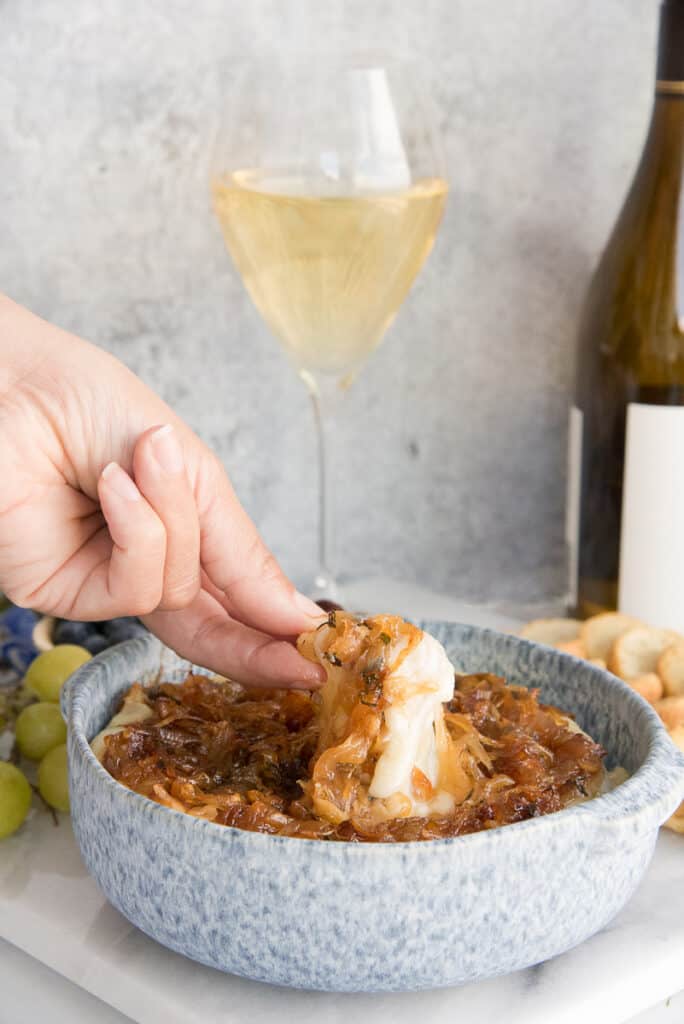
What is Brie?
Brie is a soft-ripened cow’s milk cheese from France. Bries have a soft, edible rind that develops from a spray of mold it receives before it is aged. As the cheese ages within that protected, edible rind, it breaks down and becomes gooey. Brie tastes mildly nutty, creamy, and buttery. It is a great canvas for bolder flavors like these onions.
Despite being a French cheese, most of us in the States aren’t fortunate enough to have access to true French brie. French brie receives France’s coveted Appellation d’Origine Contrôlée. France’s way of saying that this cheese is not a bastard cheese from, say, Hoboken (no offense, Jersey). There are many French brie, but only a couple of “AOC-brie.” Most of the brie I’ve encountered in my local food markets is still impressive. You can find a cheese labeled AOC, grab it and the non-AOC and compare the two to see if you can tell the difference. I’m banking you won’t be able to. Not only because few grocers carry it, but also because most of us aren’t turophiles (cheese experts).
What kind of Brie cheeses are available?
There are a few different types of brie, though all aren’t available to most of us in the States. If you are reading this from Europe, you probably have a better chance at getting your hands on one or all of them. Double and triple cream brie cheeses are the most common where I live. These brie sound just like what they are: cheeses that contain double or triple the amount of butterfat in the cream with which the brie is produced. That percentage can reach up to 80% butterfat.
I tried a triple-créme brie once in a cheese shop on the Lower East Side of Manhattan and ’bout slumped to the floor in a fit of passion. I haven’t been able to locate a triple-créme since, but you’ll know about it when I do because I’ll be blowing up your social media.
In Europe or in a specialty cheese shop, you are more likely to find the remaining brie cheeses- de Meaux, de Melun, non-AOCs, or de noir. Herb brie, the seventh and final brie type, is more commonly available in grocery stores. Not that they’re really impressive.
What is a baked Brie?
I recommend becoming familiar with how to bake a brie. Especially since brie is one of the most versatile cheeses to jazz up for your parties. You can bake brie on its own or topped with these caramelized onions. But, you can also wrap brie in puff pastry and bake it, smoke it, or slather it with fruit compotes. You don’t have to bake brie. You can just let it warm to room temperature and enjoy it. I’ve made and served brie in many ways. I’ve yet to find disappointment in the eyes of my guests when they’ve eaten it.
But baked brie topped with caramelized onions is the resounding favorite. So, let’s get to it.
What do I need to make Baked Brie with Caramelized Onions?
You need onions (yellow or white works), garlic, fresh thyme, dry white wine, brown sugar, and salt to make this recipe. Clearly, I am in the thick of the holiday season because I forgot the brie. You need a large wheel of brie.
You caramelize the onions in a sauté pan. The baked brie goes into a nice baking dish or cake pan.
What’s the difference between sauteéd onions and caramelized onions?
I start by caramelizing my onions. Because you can store caramelized onions in the fridge for up to 2 weeks, they can be prepared ahead. Caramelized onions are cooked longer than sauteéd onions. Because caramelized onions are allowed to break down during cooking, they taste less oniony. The result is a deep, sweet-tasting onion vs. the light-colored, more pungent flavor of sauteéd.
You can use white or yellow onions to make this topping. Cut the stem end off the onions, peel them, and cut them in half through the root. Leave the root end intact until you slice them. This gives the onions an anchor point to hold them together while you cut. Make 1/4-inch thick slices parallel to the root. Once the onion is sliced, cut a v-shape over the root to remove it. Use your hands to break up the slices. Continue slicing the remaining halves of the onions.
Peel, then thinly slice the garlic cloves as well. I also like to remove the thyme leaves from their stems at this point.
How long does it take to caramelize onions?
Some recipes say you can caramelize onions in 10 minutes. Yeah, no. Good caramelized onions take at least 45 minutes to make. At least. Surprisingly enough, onions are sweet. You don’t know that unless you take the time to cook down the noxious chemical they contain. Once you break down the onion, the sweetness comes through. If you cook them long enough, you don’t need to add additional sugar. Since we’re going to continue cooking the onions on the brie, I limit their stovetop cooking to 45 minutes. If you want to experiment, go up to an hour and omit the sugar. I recommend only doing this if you don’t plan to cook them a second time.
Melt the butter over medium-high heat in a 12-inch sauté pan (you can also use a skillet). Once the butter has melted, add all onions and the garlic to the pan. Use a spoon to toss the onions and garlic in the melted butter. Sauté the onions and garlic, frequently stirring, for 3 minutes. The aromatics will begin to look milky-white and glossy.
Why do you salt the caramelized onions?
Sprinkle the salt over the onions in the pan and toss the two together. Continue sweating the onions for another 2 minutes, frequently stirring.
Salt draws out the moisture in whatever it’s added to. When you add salt to the onions that you are caramelizing, it sucks out the water in the onions to make them drier. Dry onions caramelize quicker and more evenly.
What does brown sugar do to the caramelized onions?
You don’t have to add additional sugar to caramelized onions because onions naturally contain sugar. The issue is, it takes a good amount of time to really get to the sweetness level you want in caramelized onions. The longer you cook them, the sweeter they become, which also means they’re easier to burn. Sugar is a cheat. A respectable cheat, but a cheat nevertheless. Adding sugar to caramelized onions helps sweeten the onions without the risk of cooking them so long they burn.
Add the brown sugar to the onions in the pan and toss these together.
Reduce the heat to medium-low and cook the onions for 15 minutes. Be sure to stir the onions around in the pan every 3-4 minutes. Both the salt and sugar will leach out the excess moisture from the onions and garlic. Once most of that moisture that pools in the pan have evaporated, you need to stir more often. This will keep the onions from browning too fast.
After 15 minutes, the onions will look golden.
What kind of wine do I use to caramelize the onions?
The old adage, use a wine you’d drink from a glass, is important here. As with most recipes where wine is involved, we’re cooking this wine down. If you cook down a gut-rot wine, your caramelized onions will taste like poo. Instead, use a good-quality drinking wine to deglaze the pan with the caramelized onions. A dry (not sweet) white wine is important when it comes to the white wine variety. You don’t want to add more sweetness to these already sweet onions. Dry white wines are sauvignon blanc and chardonnay. If you can’t get your hands on one of those, use pinot grigio. Pinot grigio is less dry, but it isn’t too sweet.
Increase the cooking temp to medium. Pour the wine into the pan and use your spoon to scrape up any stuck-on food particles from the bottom of the pan. This is called deglazing the pan. The wine acts as a catalyst to loosen the bits of food, making the end result even more flavorful.
Next, add the thyme leaves to the pan. You can replace the fresh thyme with dried thyme leaves, but fresh tastes much brighter. Bring the wine in the pan up to a gentle simmer.
Once the wine in the pan comes to a simmer, reduce the heat down to medium-low again. Continue to cook the onions for another 20 minutes. Stir frequently (every 2-3 minutes) to keep the onions on the bottom from browning faster than the ones on top. If you find that the onions in the pan are browning too quickly- say within 10 minutes- reduce the heat to low.
How far ahead can I make the caramelized onions?
Remember, since we’re going to bake these on the brie, we don’t want them to be too dark. Once the onions are a nutty brown color, remove them from the heat and allow them to cool slightly. You can also transfer them to a food storage container and use them later.
You can make caramelized onions two weeks before you plan to use them. Allow the onions to cool completely, transfer them to an air-tight container and store them in the fridge. You can use caramelized onions to top brie, burgers, pizzas, or sandwiches. I would totally double this recipe for all of those applications.
Can you freeze caramelized onions?
You can freeze caramelized onions for 2 months. Allow the onions to cool after caramelizing them and transfer them to a freezer-safe container. When you’re ready to use them, thaw them in the fridge.
How do I make the Baked Brie?
To make the baked brie, first, slice off the top rind of the brie. Again, the rind on brie is edible, so you don’t need to slice it off. I do this for this recipe because it exposes the gooey cheese within. When I don’t slice off the top rind, the rind bakes firm between the cheese and the onions. This lack of blending of the brie and onions troubles my spirit. I don’t like it.
Once the rind is sliced off, place the wheel of brie into a lightly-greased, oven-safe baking dish. Nineteen-ounce wheels of brie are usually 6 to 8-inches in diameter, so an 8-inch dish works well. I try to bake my brie in a pretty dish so it can go from oven to display with no hassle. If you don’t have a ceramic baking dish, you can use a cake pan instead. You can also bake the brie on a parchment-lined sheet pan, but you may experience some oozing and a less compact shape.
Do I have to make Baked Brie?
Well, no. You don’t have to use this baked brie recipe to make baked brie. You can replace brie with camembert. Both have similar flavors. Camembert is slightly more robust and earthier than brie, though. You can also replace the cow’s milk brie with goat’s milk brie. Goat’s milk brie tastes more tangy and acidic.
How far ahead can I make the Baked Brie?
Baked brie tastes good at room temperature, but it’s not gooey. Brie stays gooey for 15 minutes once it’s baked. As a result, I don’t recommend baking too far ahead if gooiness is your goal. Again, brie is safe to serve at room temperature. But, if you want melty cheese, it’s best to wait about 45 minutes before you plan to serve it to start baking it.
Top the brie with the caramelized onions. Slide the baking dish into a preheated 350°F (177°C) oven. Bake the brie, uncovered, for 30 minutes.
How do I serve Baked Brie?
After 30 minutes, the onions will be a dark brown color. The brie will ooze from the sides of the wheel. That’s when you know you can take it out. If your baked brie doesn’t look like any of that, bake it for another 10 minutes or until it does.
Remove the baking dish from the oven and serve it immediately. I mean, well, put it out. Warn your family or guests that it’s still molten cheese, so it will be hot. But, you do want to serve and enjoy it shortly after removing it from the oven. As it cools, the cheese will become firmer. You can put a spoon or a cheese knife to make serving more hygienic and easier.
Serve this baked brie with slices of baguettes, chips, or your favorite water crackers. I add this brie to a board with charcuterie, fresh fruits, and olives.
Can you reheat Baked Brie?
You can reheat the baked brie once more if you can’t bring yourself to eat non-gooey cheese. Place it back into the hot oven for 10 minutes to loosen the cheese. I recommend doing this only once because after that, the brie forms a funky, hard crust that is just bleh.
Just a reminder that there’s nothing wrong with eating room temperature brie.
How do I store leftovers?
Store leftover baked brie covered in plastic wrap in the fridge for 3 days. If you haven’t reheated it already, you can do so in a 350°F (177°C) oven for 10-12 minutes. Remove the brie from the fridge and allow it to warm up for 15 minutes before reheating. This will make its time in the oven more efficient.
Can I freeze Baked Brie?
You cannot freeze baked brie or unbaked brie. I mean, well, you can. You can do anything, but freezing brie is not a good idea. Because brie contains a good amount of water, freezing it will ruin the consistency once it’s thawed. Brie keeps well in the fridge, so I recommend storing it there over freezing it. You can freeze the caramelized onions, though.
To round out your soiree, prepare a nice meat and cheese tray with the baked brie nestled into the middle like a little piglet…no, not you, the brie. Be sure to pin this recipe to your party boards. If you make it, let me know what you think in the comments below!
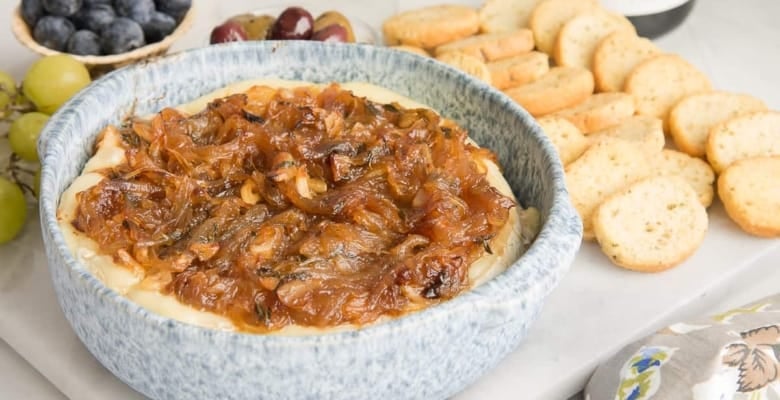
Baked Brie Topped with Caramelized Onions
at Sense & EdibilityIngredients
- 2 tablespoons (28 grams) unsalted butter
- 2 large (about 5 cups) yellow onions peeled and sliced
- 3 cloves garlic peeled and thinly sliced
- 3/4 teaspoon kosher salt
- 2 tablespoons (25 grams) light brown sugar
- 1 cup (250 milliliters) dry white wine
- 2 tablespoons fresh thyme leaves (from 1 large stem), plus more to garnish
- 19 ounce (555 grams) brie top rind removed
To Serve (optional)
- 1 baguette sliced
Instructions
Sweat the Aromatics
- In a 12-inch skillet or frying pan, melt the butter over medium high heat.Stir the onions and garlic into the melted butter. Sprinkle the salt over the onions and garlic in the pan.
- Sauté the onions and garlic for 3-4 minutes, or until they appear milky- almost opaque- in color. Reduce the heat to medium-low and add the brown sugar. Stir the sugar into the onions and garlic.
- Sauté this mixture 15 minutes, or until the onions begin to turn light-golden brown. Stir the onions once every 5 minutes while they are sauteing.
Deglaze the Pan
- After 15 minutes, the pan will have developed a thin brown crust of caramelized liquid. Deglaze the pan by pouring in the wine and scraping the bottom of the pan with a wooden spoon to remove the browned bits. Sprinkle the thyme leaves over the onions.
- Continue cooking the onions, stirring once every 3-5 minutes, over medium-low for 15-20 minutes, or until the onions turn a deep brown color. If the onions are browning too quickly, reduce the heat to low.
- Remove from the pan to a clean bowl or plate and allow to cool for 5-10 minutes.Preheat your oven to 350°F. Lightly spray a 6 inch cake pan or ceramic baking dish with non-stick cooking spray.
Bake the Brie
- Place the wheel of brie- top rind sliced off and discarded- into the baking dish with the cut side up. Nestle it into the pan so it sits level.
- Top the brie with the caramelized onions.Place the baking dish into the preheated oven and bake the brie, uncovered, for 30-35 minutes, or until the brie is melted.
- Remove the baking dish from the oven and allow to cool for 5-10 minutes before serving.
- Top with more fresh chopped thyme, if desired. Spoon or scoop the brie on toasted baguette slices to eat.
Notes
Swaps and Substitutions:
- Replace the white wine with white wine vinegar, balsamic vinegar, or vegetable stock.
- Use camembert or goat's milk brie instead of brie.
- Omit the brown sugar.
- Replace the thyme with rosemary.
Tips and Techniques:
- To reheat the baked brie: place it back into a hot (350°F/177°C) oven for 10 minutes to loosen the cheese. I recommend doing this only once as the brie forms a crust after baking a second time.
Make-Ahead Instructions:
- Prepare the caramelized onions up to 2 weeks ahead. Store the cooled onions in a food storage container in the fridge.
Storage Instructions:
- Store leftover baked brie covered in plastic wrap in the fridge for 3 days.
- Remove the brie from the fridge and allow it to warm up for 15 minutes before reheating.
- If you haven't reheated it already, you can do so in a 350°F (177°C) oven for 10-12 minutes.
Freezing Instructions:
- To freeze caramelized onion:
- Allow the onions to cool to room temperature.
- Transfer the onions to a freezer-safe container and freeze for up to 2 months.
- Thaw the onions in the fridge and stir before using.
- Don't freeze brie. Its water content will cause it to become grainy after thawing.

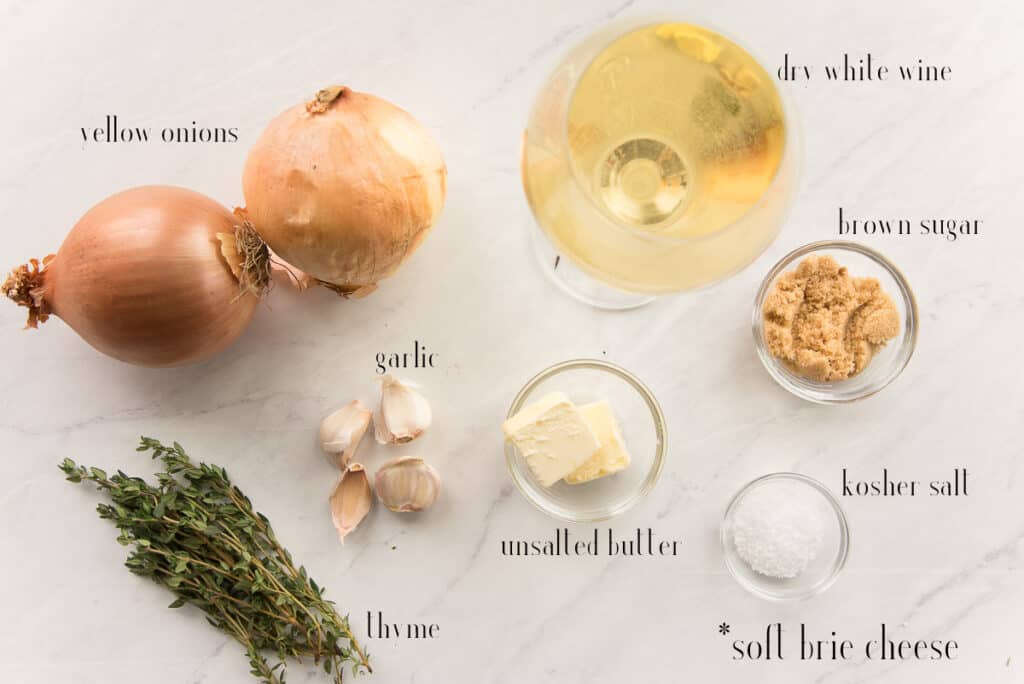
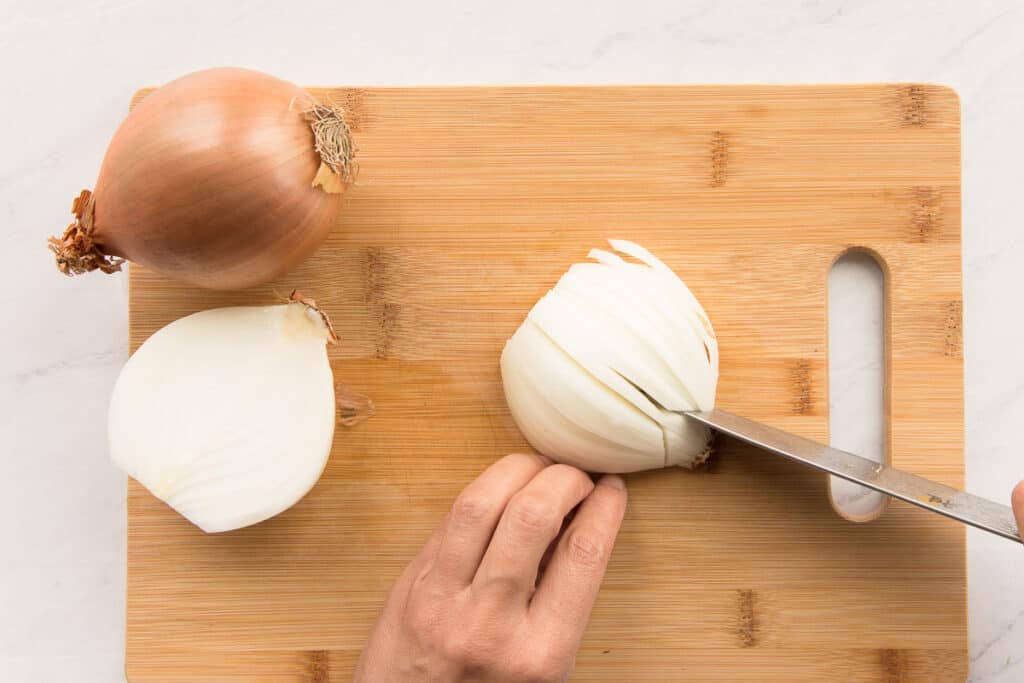
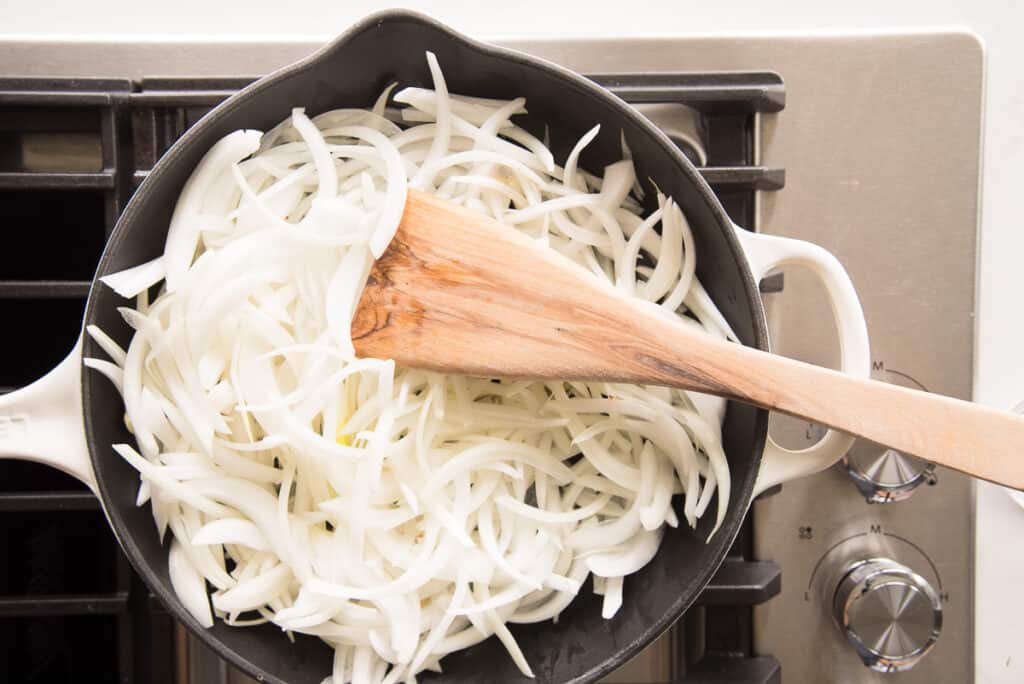
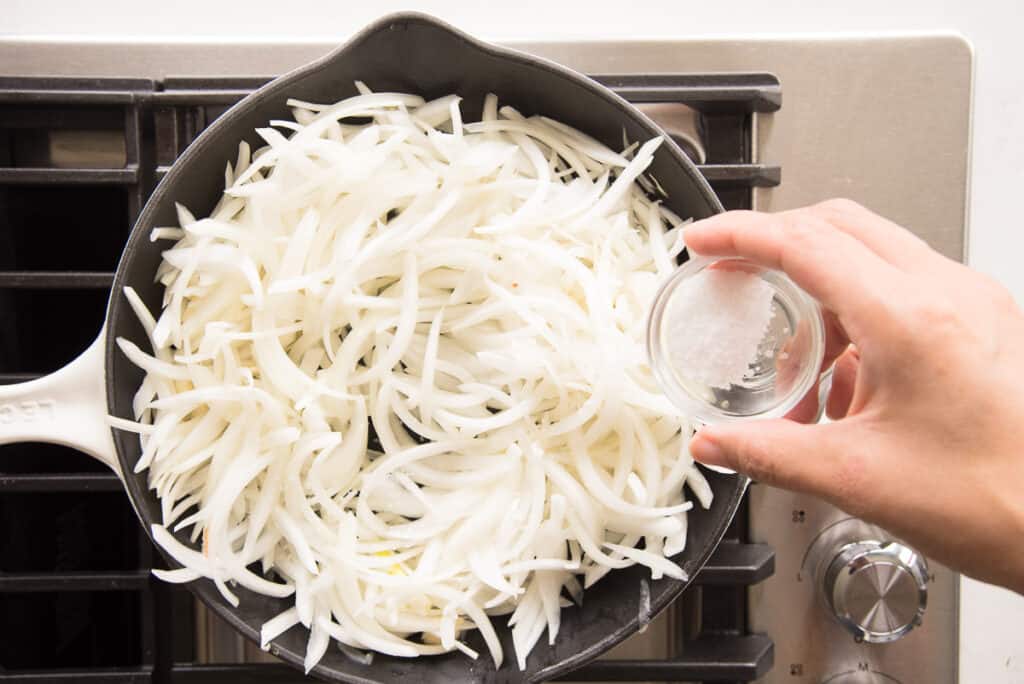
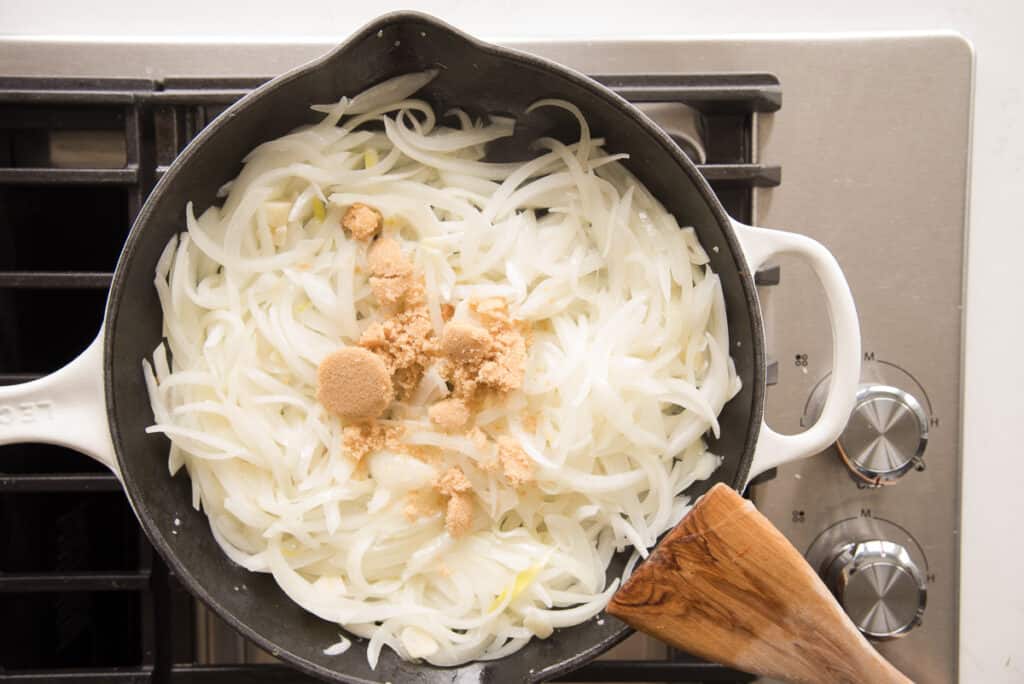
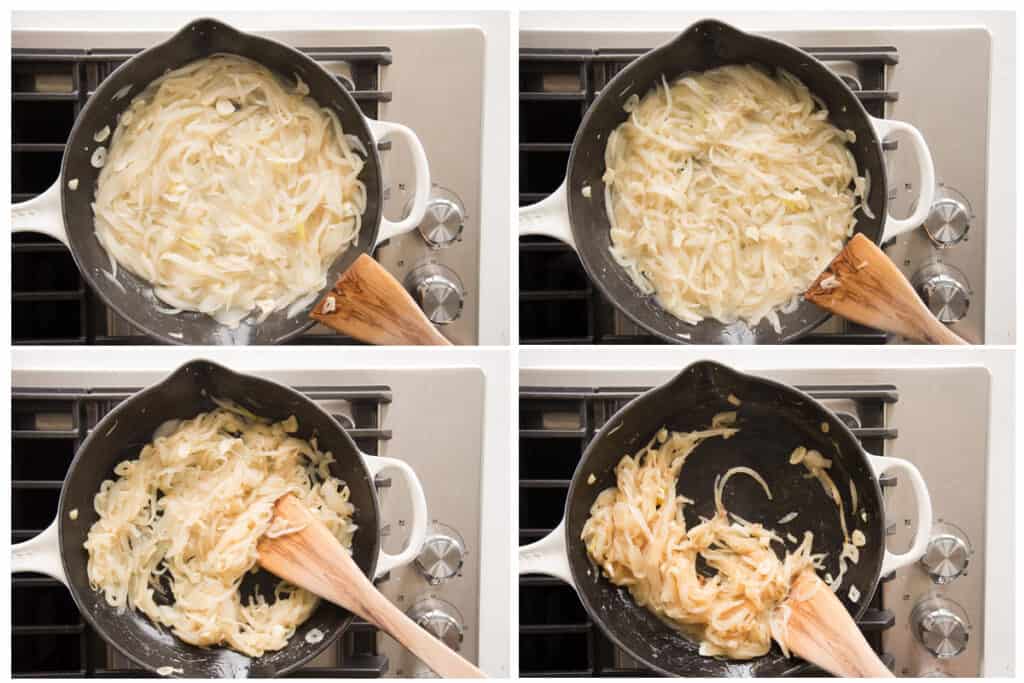

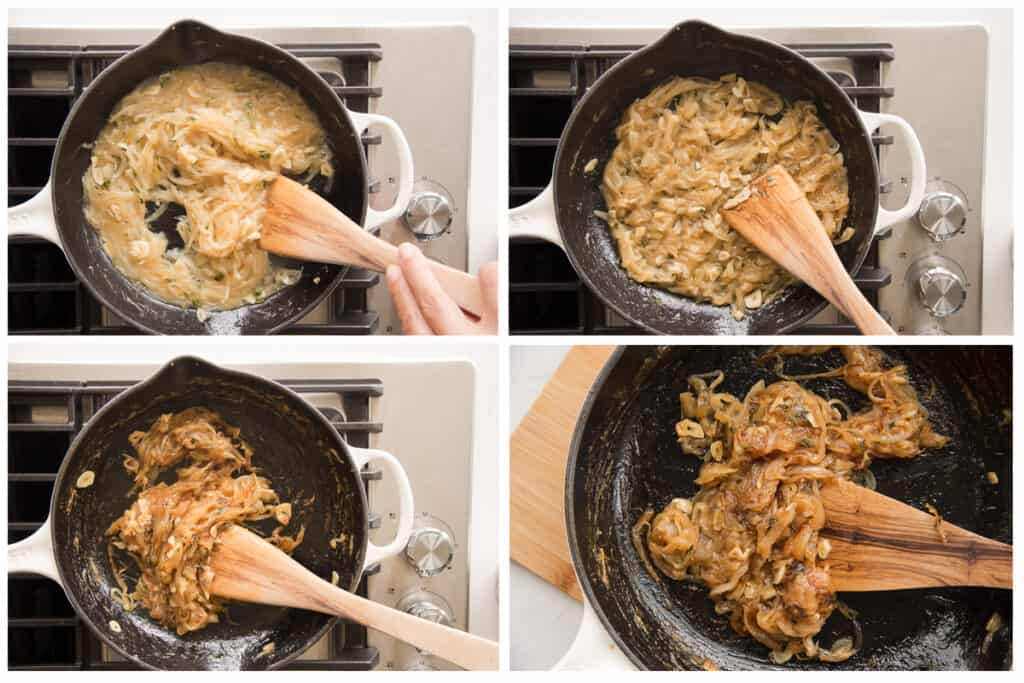
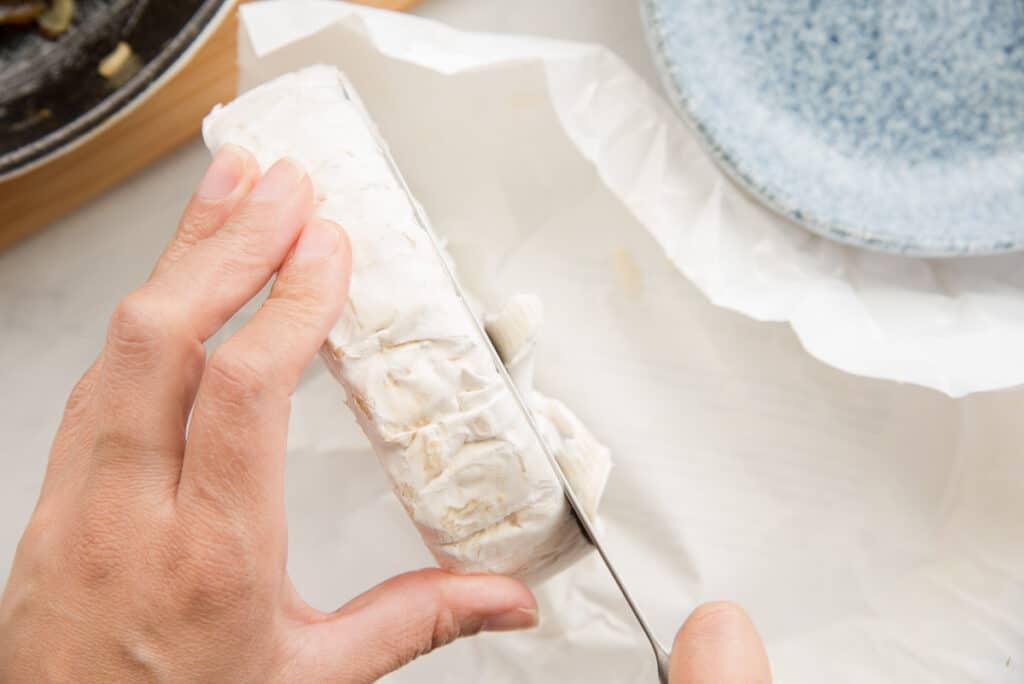
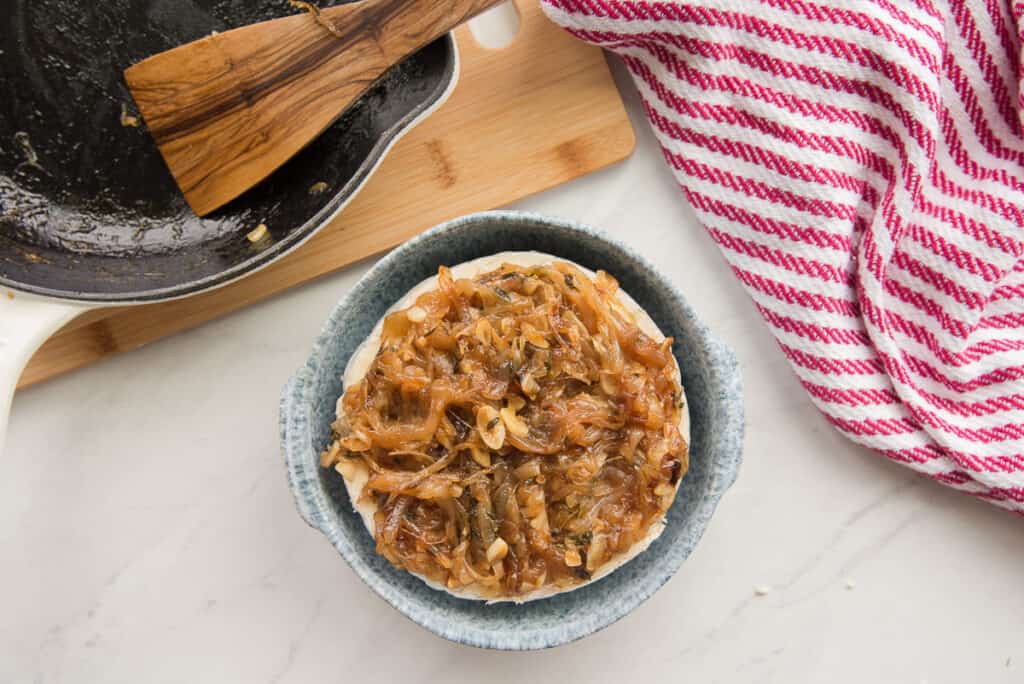
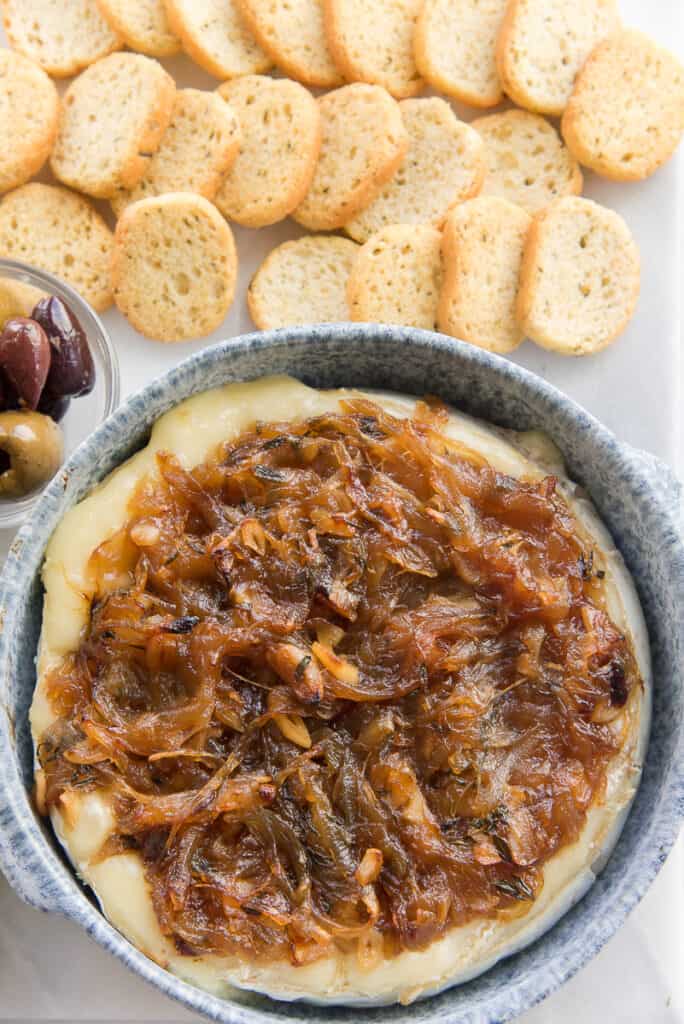
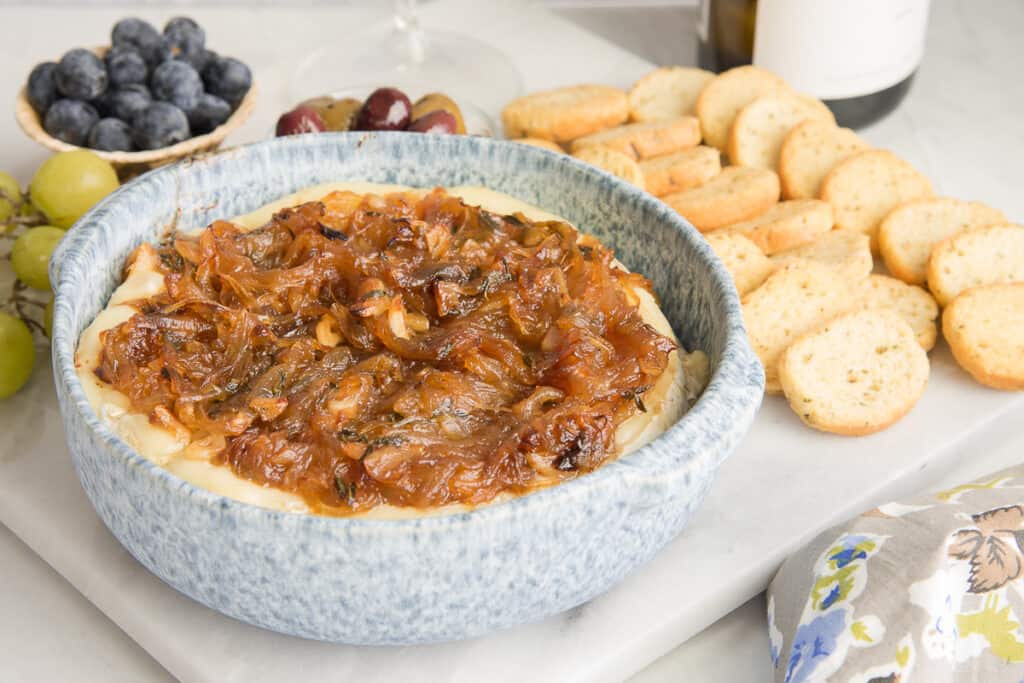
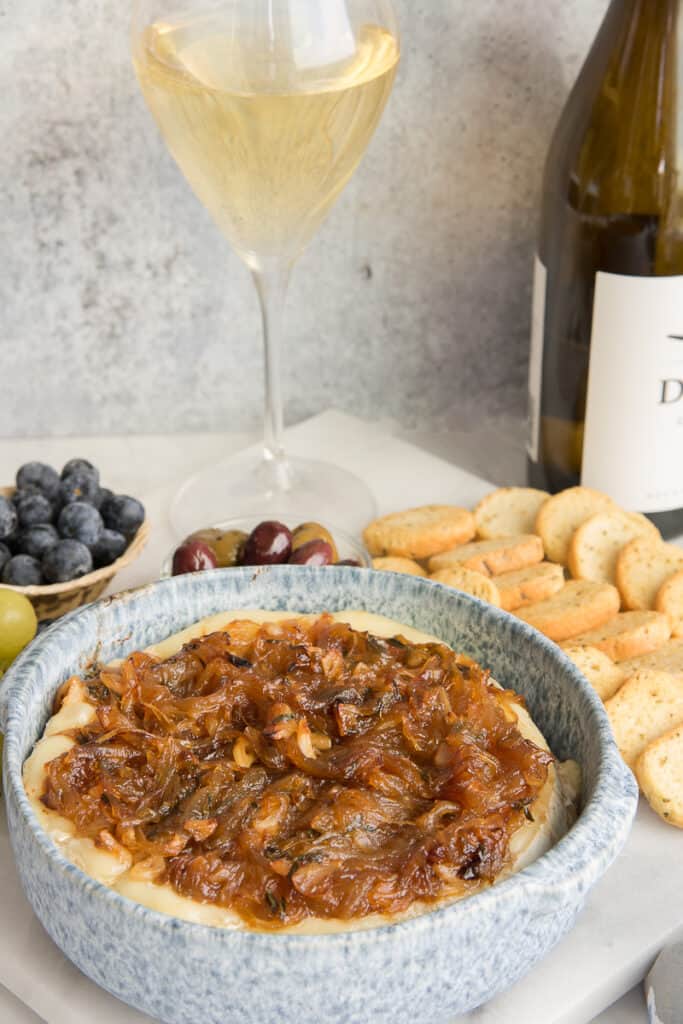


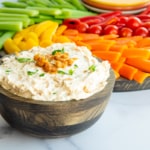
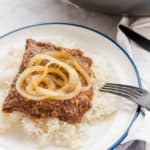
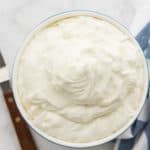

OMG this is so easy and so delicious! We had a holiday gathering and I was hoping to have some leftovers..umm nope!!!! All gone! I guess I will just have to make some more for myself! Hahahahaha
We fight over it in our house, Xenia.
I’ve never tried brie before, now I want to! Love all the helpful information on caramelising onions
It will be ooey-gooey and full of flavor, Helen.
Oh my goodness, I LOVE baked brie! But I have never thought about pairing it with caramelized onions. Cannot wait to enjoy this on new year’s eve!
It will be a Happy New Year for sure, Nadalie!